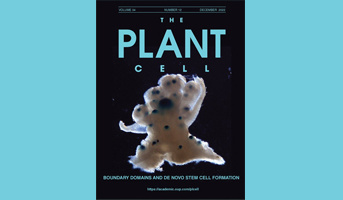Formation of stem cells in meristems newly formed by plants
The architecture of plants is a plastic trait contributing to the adaptation of plants to their environment and a major agronomic feature. Branching resulting from the growth of newly formed axillary meristems is a crucial parameter of plant architecture. In addition to new shoots, axillary meristems can also give rise to inflorescences or flowers. Branching involves the creation of new growth points, called meristems, which house stem cells. The establishment of a new population of stem cells in axillary meristems is essential for their activity. Thus, understanding the formation of new meristems and their stem cells is of both fundamental and agronomic interest. Recent work in the "Transcription Factors and Architecture" FTA team reveals a new key step in the meristem formation process.
The formation of an axillary meristem involves an initiation phase followed by a structuring phase during which the meristem acquires its characteristic organization and stem cells1. Studies by Nicolas et al.2 demonstrate that while the activity of CUP-SHAPED COTYLEDON (CUC) genes is essential for the early stages of meristem initiation, it must be repressed by NGATHA-like factors to allow the transition to the second phase, during which stem cells form. Mutation of NGATHA-like factors also affects the establishment of stem cells in modified axillary meristems, such as flowers, but not in the meristem formed in the seed3. These results suggest that other regulators are involved during this initial stage of plant morphogenesis.
This work paves the way for a more in-depth molecular study of the interactions between gene networks controlling meristem initiation and their structuring. In particular, the possible interaction between CUC transcription factor genes and stem cell regulators WUSCHEL and CLAVATA would be worth investigating. Simultaneously, the generality of the mechanism revealed here could be tested by studying meristem formation in other species. Finally, the implication of the mechanism revealed in this study in the variation of plant architecture in response to environmental signals could be analyzed.
The entire study has been validated through three publications:
> A review discussing the specificities of regulatory networks during meristem formation compared to established meristems 1
> A central publication revealing the role of the interaction between NGAL and CUC genes during the formation of axillary and floral meristems 2
> A complementary publication showing that this interaction does not occur during meristem formation in the seed 3
Associated publications:
1 Nicolas A, Laufs P. Meristem Initiation and de novo Stem Cell Formation. Front Plant Sci. (2022)13. doi:https://doi.org/10.3389/fpls.2022.891228
2 Nicolas A, Maugarny-Calès A, Adroher B, Chelysheva L, Li Y, Burguet J, et al. De novo stem cell establishment in meristems requires repression of organ boundary cell fate. The Plant Cell. (2022) 1–22. doi: https://doi.org/10.1093/plcell/koac269
3 Nicolas A, Laufs P. The NGATHA-like Genes DPA4 and SOD7 Are Not Required for Stem Cell Specification during Embryo Development in Arabidopsis thaliana. Int J Mol Sci. (2022) 23: 12007. doi: https://doi.org/10.3390/ijms231912007
Research developed at the Institute Jean-Pierre Bourgin for Plant Sciences
Back
